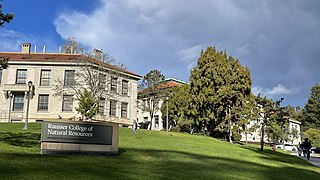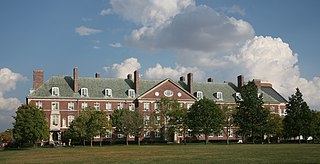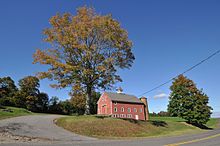
The University of Connecticut (UConn) is a public land-grant research university system whose main campus is in Storrs, Connecticut. It was founded in 1881 as the Storrs Agricultural School, named after two brothers who donated the land for the school. In 1893, the school became a public land grant college, becoming the University of Connecticut in 1939. Over the following decade, social work, nursing and graduate programs were established, while the schools of law and pharmacy were also absorbed into the university. During the 1960s, UConn Health was established for new medical and dental schools. UConn is accredited by the New England Commission of Higher Education.

UConn Health is the branch of the University of Connecticut that oversees clinical care, advanced biomedical research, and academic education in medicine. The main branch is located in Farmington, Connecticut, in the US. It includes a teaching hospital, the UConn School of Medicine, School of Dental Medicine, and Graduate School. Other community care satellite locations exist in Avon, Canton, East Hartford, Putnam, Simsbury, Southington, Storrs, Torrington, West Hartford, and Willimantic, including two urgent cares in both Storrs and Canton. The university owns and operates many smaller clinics around the state that contain UConn Medical Group, UConn Health Partners, University Dentists and research facilities. Andrew Agwunobi stepped down as the CEO of UConn Health in February 2022 after serving since 2014 for a private-sector job. Bruce Liang is UConn Heath's interim CEO and remains dean of the UConn School of Medicine.

Animal science is described as "studying the biology of animals that are under the control of humankind". It can also be described as the production and management of farm animals. Historically, the degree was called animal husbandry and the animals studied were livestock species, like cattle, sheep, pigs, poultry, and horses. Today, courses available look at a broader area, including companion animals, like dogs and cats, and many exotic species. Degrees in Animal Science are offered at a number of colleges and universities. Animal science degrees are often offered at land-grant universities, which will often have on-campus farms to give students hands-on experience with livestock animals.

The Rausser College of Natural Resources (RCNR), or Rausser College, is the oldest college at the University of California, Berkeley and in the University of California system. Established in 1868 as the College of Agriculture under the federal Morrill Land-Grant Acts, CNR is the first state-run agricultural experiment station. The college is home to four internationally top-ranked academic departments: Agriculture and Resource Economics; Environmental Science, Policy, and Management; Nutritional Sciences and Toxicology; and Plant and Microbial Biology, and one interdisciplinary program, Energy and Resources Group. Since February 2020, it is named after former dean and distinguished professor emeritus Gordon Rausser after his landmark $50 million naming gift to the college.

The University of Illinois Urbana-Champaign's College of Agricultural, Consumer and Environmental Sciences (ACES) is part of the University of Illinois Urbana-Champaign and is considered by some to be the top school of agriculture-related sciences in the world. Most of the ACES buildings are located on the South Quad. In terms of staff, ACES has 186 tenure-system faculty, 78 specialized faculty, 26 postdoctoral researchers, 493 academic professionals, 565 civil service staff, 323 assistants, and 956 hourly employees.

The University of Florida Institute of Food and Agricultural Sciences (UF/IFAS) is a teaching, research and Extension scientific organization focused on agriculture and natural resources. It is a partnership of federal, state, and county governments that includes an Extension office in each of Florida's 67 counties, 12 off-campus research and education centers, five demonstration units, the University of Florida College of Agricultural and Life Sciences, three 4-H camps, portions of the UF College of Veterinary Medicine, the Florida Sea Grant program, the Emerging Pathogens Institute, the UF Water Institute and the UF Genetics Institute.

IPB University is a state-run agricultural university based in the regency of Bogor, Indonesia.
R. Michael Roberts is an American biologist who is the Chancellor's Professor Emeritus of Animal sciences and Biochemistry at the University of Missouri. He is a founding co-editor of the Annual Review of Animal Biosciences, first published in 2013.
The College of Food, Agricultural and Natural Resource Sciences (CFANS) is one of seventeen colleges and professional schools at the University of Minnesota. The College offers 14 majors, 3 pre-major and pre-professional majors and 26 freestanding minors for undergraduate students and a variety of graduate study options that include master's, doctoral and joint degree programs.

Sokoine University of Agriculture (SUA) is a public university in Morogoro, Tanzania, specializing in agriculture. The university is named after the country's second prime minister Edward Sokoine.

Vietnam National University of Agriculture, until 2014 Hanoi University of Agriculture (HUA), is an education and research university specializing in the agricultural sector. The university is located in Trau Quy town, Gia Lam district, a Hanoi suburban area, about 12 km far from Hanoi city centre.
The Department of Agrobiotechnology (IFA-Tulln) is one of the 15 departments of the University of Natural Resources and Life Sciences, Vienna (BOKU) operated in cooperation with the Vienna University of Technology and the University of Veterinary Medicine Vienna at the Campus Tulln Technopol.
Gordon Lee McClymont AO was an Australian agricultural scientist, ecologist, and educationist. The originator of the term "sustainable agriculture", McClymont is known for his multidisciplinary approach to farm ecology. McClymont was the foundation chair of the Faculty of Rural Science at the University of New England, the first degree program of its kind to integrate animal husbandry, veterinary science, agronomy, and other disciplines into the field of livestock and agricultural production. In 1978, in recognition of his work and contributions to his field, he was appointed Officer of the Order of Australia.
The Washington State University College of Agricultural, Human, and Natural Resource Sciences (CAHNRS) is one of the 11 colleges of Washington State University that offer undergraduate and graduate programs. Established as Washington Agricultural College and School of Science, the college started instructions on January 13, 1892. The college is in Pullman, Washington, and became a land-grant college after the passage of Morrill Act. The college provides education, research and services through fifteen academic departments, four research and extension centers, and thirty-nine county extension offices across the state of Washington. The college is known for apple production, grape growers and small grain genetics and breeding.

The Lilongwe University of Agriculture and Natural Resources (LUANAR) is a university outside Lilongwe, Malawi. It was formed in 2011 by a merger between Bunda College of Agriculture of the University of Malawi and Natural Resources College (NRC).

Benjamin Franklin Koons was an American natural historian who served as second Principal of Storrs Agricultural School (1883–1893) and first President of Storrs Agricultural College (1893–1898), now the University of Connecticut.

Harry Lucian Garrigus was an American animal scientist, livestock breeder, and educator who worked at the University of Connecticut (UConn) from 1900 to 1942. Garrigus served as Professor of Animal Husbandry from 1907 until his retirement. Two of his sons and one of his grandsons followed in his footsteps, teaching animal sciences at public universities in the Upper South and Midwest.
The Storrs Agricultural Experiment Station (SAES) is an American agricultural experiment station operated by the University of Connecticut and founded in 1887. Part of UConn's College of Agriculture, Health, and Natural Resources, the SAES directs agriculture-related research while the university's Cooperative Extension Service engages in community education and outreach. Kumar Venkitanarayanan is the Station's associate director. Its offices are located in the W. B. Young Building in Storrs.
Delia Grace is an epidemiologist and a veterinarian. Grace joined the University of Greenwich in May 2020 as Professor of Food Safety Systems at the Natural Resources Institute. She is also Joint Appointed Scientist, Animal and Human Health Program at the International Livestock Research Institute (ILRI), Nairobi, Kenya.
















